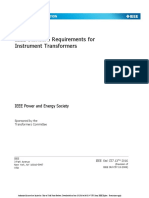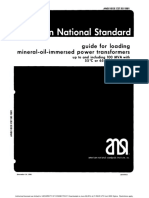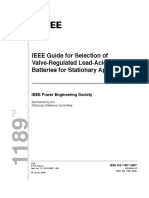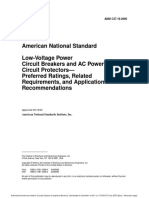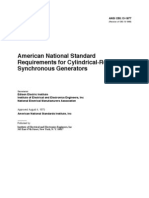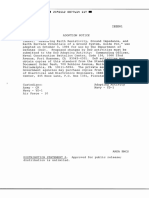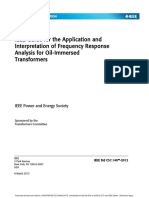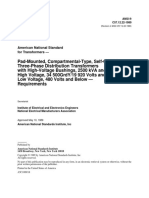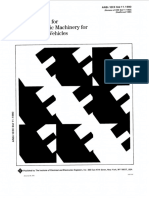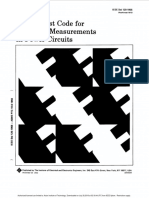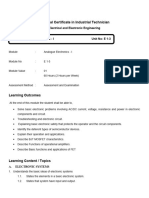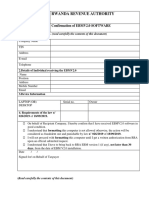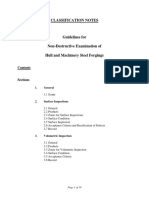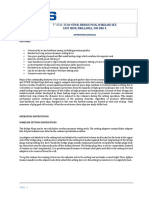Ansi Ieee C57.13.1 1981
Ansi Ieee C57.13.1 1981
Uploaded by
Sven StevenCopyright:
Available Formats
Ansi Ieee C57.13.1 1981
Ansi Ieee C57.13.1 1981
Uploaded by
Sven StevenOriginal Title
Copyright
Available Formats
Share this document
Did you find this document useful?
Is this content inappropriate?
Copyright:
Available Formats
Ansi Ieee C57.13.1 1981
Ansi Ieee C57.13.1 1981
Uploaded by
Sven StevenCopyright:
Available Formats
IEE_E __ ~~7.13.1 81 • 4805702 0048942 6 • A-3q- 0/ ANSI/lEEE C57.18.1.
1981
(Reaffirmed 1986)
CANSI Reaffirm"d 1987)
An American NationalStandard
IEEE Guide for Field Testing of Relaying Current Transformers
Sponsor
Power System Relaying Committee
of the .
IEEE Power Engineering Society
Approved March 9, 1978 Reaffirmed June 18, 1986
IEEE Standards Board
Secretariat
Institute of ElectricaJ and Electronics Engineers National Electrical Manufacturers Association
Approved December 31,1980 Reaffirmed August 25, 1987
American National Standards Institute
e Copyright 1981 by
The Institute of Electrical and Electronics Engineers, Inc
No part of thill publication may be reproduced in any form, ill an electronic reiriellol sy,tem or otherwise, withou t the prior written perm iBsion of the pu blisher.
Copyright por Institute Of Electrical & Electronics Engineers Inc Wed Mar 28 16:47:34 2001
IEEE (57·13.1 81 II 4805702 0048943 8 II
Foreword
(This Foreword it not a part of ANSI/IEEE C57 .13.1-1981, IEEE Guide for Field Tetting of Relaying Current Transformers .•
This guide was prepared by a Working Group of the Relay Input Sources Subcommittee of the IEEE Power System Relaying Committee of the IEEE Power Engineering Society.
The working group expresses its gratitude to past members, members of the Relay Input Sources Subcommittee, Power System Relaying Committee, Liaison Committees, and groups who have contributed their time and knowledge in preparing this guide.
At the time it approved this standard, C57 had the following membership:
I. H. Koponen, Chairman
C. R. Wilmore, Secretary
Organization Represented Name of Repre&entatille
, Bonneville Powel Administration. . . . . . . . . . . . . . . . . . . . . . . . . . • . . . • . . . . . . Georgo W. Dlff
Electric Light and Power Group. . . . . • . . . . . . . . . . . • . . . . . . . . . . . . . . . . . . . . R. R. Bast
I. O. Berkhan
I. H. Koponen
J. P. Markey (AU) B. F. Smith
E. A. Villuuso
Institute of Electrical and Electronics F.nglneers . : . . . . . . . . . . . . . . . . . . . . . . . .. S. Bennon W. P. Burt
J. C. Dutton D. C. Johnson L. W. Long
D. E. Massey
National Electrical Manufacturers Association •••••..••••. , .•..••.•....••.. L. C. Aicher
W. R. Courtade J. D. Douglass W. C. Kendall
C. W. Mayall (Alt) W. J. McNutt
Norman M. Neagle (Alt) R. L. Schwab
R. E. Uptegraff', Jr G. C. Wilburn
Rural Electrification Administration. . . • . .. . • . . . . . . . . . ... . . . . . . • . . . . . . .. J. C. Arnold, Jr Tennessee Valley Authority .....•........•...........•.....••......•. L. R. Smith Underwriters Laboratories. , •....................................... W. A. Farquhar (AIt)
_ E. J. Huber
U.S. Bureau of Reclamation ....................• ' S. J. Baxter
The Relay Input Sources Subcommittee of the Power System Relaying Committee of the IEEE Power Engineering Society. at the time that it reviewed and approved this guide, had the following membership:
D. R. Volzka, Chairman F. G. Basso
J. Berdy
J. L. Blackburn C. F. Burke
M. B. DeJarnette C. ,M. Gadsden F. B. Hunt
W. C. Kothelmer
J. W. Walton, Secretary W. A. Lewis
M. D. Limerick J. Miller
A. It. Summers A. Sweetana
d. M. Vanderleck L. N. Walker E.C. Wentz
Copyright por Institute Of Electrical & Electronics Engineers Inc Wed Mar 28 16:47:40 2001
IEEE (57·13·1 81 II 4805702 0048944 T II
At the time this guide was approved the members of the working group of the Relay Input Sources Subcommittee were:
C.F. Burke D. H. Colwell
D. R. Volzka, Chairman
F. E. Newman
M. D. Limerick R. E. Linton
When this guide was approved March 9, 1978, the IEEE Standards Board had the following membership:
Joseph L. Koepfin.ger, Chairman
William E. Andrus C. N. Berglund Edward J. Cohen Warren H. Cook David B. Dobson R. O. Duncan Cllarles W. Flint
Ivan G. Easton, Secretary
Jay Forster
Ralpb I. Hauser Loering M. Johnson Irving Kolodny William R. Krueai Thomas J. MlIl1l.n JohnE. May
Copyright par Institute Of Electrical & Electronics Engineers Inc Wed Mar 28 16:47:41 2001
Irvin N. Howell, Jr, Vice Chairman
Donald T. Michael Voss A. Moore Willlam S. Morgan Robert L. Pritchard Blair A. Rowley Ralph M. Showers B. W. Whittington
--------~--- - .,._-
IEEE (57.13.1 81 II 4805702 0048945 1 II
Contents
SECTION PAGE
1. Introduction .•................... .- : .- , " 7
. .
2. Ccnsideration of American National StandardsJnstitute (ANSI) Accuracy Classes .•.... 7
3. Safety Considerations in Field Testing C~ent Transformers. . . . . . . • . . . • . . . . . . • • . •. 7
4. Current Transformer Types, Construction"Effect on TestMethodl!: .. ; ., •.. ~'" .; .'. ;;·;·8 4.1 Bushing, Window, or Bar-Type Current Transformers with
Uniformly Distributed Windings ..•.•••..... , ••. , •. , .. , ... ,. . , .. , . • • . • •• 8
'4.2 Wound CtnTent Transformers, or Those without . , .. . .".
Uniformly Distributed Windings~ ..• :; , .. '." .: ••....••............ , , .. , . . .. 8
4.3 Consideration of Remanence ..•....•......••..•...•.•••.••. ,'.' . . . • . . . . . • .. 8
5. Insulation Resistance Tests .- .: "~ .~ -:': .' •... ; : .. '. ,', •. : . . . . . . . . . . . .. 9
" .
6. Ratio Tests ,,- .. ~"4 , ~ ~ ,-", , "" , ., .-, .. I"~ •• -Jo" • _~ ~ •• ,- .,' ,., , .. , ~~ •••• --:'" .-: - ... .o_,.>oi • I • iI ...... I , ..• 10
6.1 Voltage.Method .........• , ' - , ;; ,'. ; ' f. ,'.'., ..•.•.•.... 10
6.2 CurrenfMs,thod: c; .....• h: ; . ;'. ' , , .. :';;'", .. '. .. , , 10
. ~.; . - .,-
7. Polarity Check , , , , , .. , , , 11
7.1 DC Voltage Test , 11
7.2 AC Voltage Test - Oscilloscope .••.• , ...•....•.....•...•.•....••....... 12
7.3 Current Method .... , .. ".,',., ........•.••.... " .. ,,"', , ••.... 12
8. Winding and Lead Resistance (Internal Resistance) , •.•. , ..• , , , ..•..•. 18
9. Excitation Test , 13
10. Burden Measurements , , , , .. , 15
11. Specialized Situations , ...........• , ...........•......... 15
11.1 Current Transformers in a Closed-Delta Transformer Connection 15
11.2 Generator Current Transformers •.•...• , , , .....•. , .••....... 16
11.3 Intercore Coupling Check , , .. , 15
I!'lGURES
Fig 1 Fig 2 Fig 3
Fig 4 Fig 5 Fig 6 Fig 7 FigS Fig 9 Fig 10
Uniformly Distributed Secondary Winding. . . . . . . • . . . . . . . . . . . . . . . . . . . . • . . . .. 8 Leakage Flux Associated with Class T Current Transformers . , . , .•.. , .. , ..• , •. ,. 8 Hysteresis Curves; A .. - Normal Hysteresis Curve; B - .. Hysteresis
Curve with Remanence .. , , ... , .•.....................•....... , .... , . . .. 9
Ratio Test by Voltage Method ...•... , •.•••. , .•. , .•..•... , ••.......•..... 10
Ratio Test by Current Method , . . . . . . . . . . . . . . . 11
Polarity Test with DC Voltage , ...• , . . . . . . . . . . . . . . . . . . . . , . . . . 11
Polarity Test with AC Voltage , , , .......• , , , ...• , 12
Polarity Test with AC Current , •.......•... , , , , ..• , . . . . 12
Excitation Test , , ....• , .•. , , , . . . . 18
Typical Excitation Curve for C Class Multiratio Current Transformer , , ..•. 14
Copyright por Institute Of Electrical & Electronics Engineers Inc Wed Mar 28 16:47:42 2001
~~~~E_C57.13.1 81 • 4805702 0048946 3 •
An American National Standard
IEEE Guide for Field Testing 'of Relaying Current Transformers
1. Introduction
In the application of protective relays, the most widely used input quantity is current. A. multiplicity of different protective relays either utilizes current directly, combines it with other currents as in differential schemes, or combines it with voltage to make impedance or power measurements. The source of relay input current is from current transformers which may be located on the bushings of power circuit breakers and power transformers, on the bus bars of metal clad switchgear, or installed as separate items of equipment located as
required. ".
The purpose of this guide is to describe field test methods that will assure that the current transformers are connected properly, are of marked ratio and polarity, and are in condition to perform as designed both initially and after 11 period of service.
2. Consideration of American National Standards Institute! (ANSI) Accuracy Classes
Relaying accuracy classes have been established in ANSI/IEEE C57.13-1978, Requirements for Instrument Transformers, to specify the performance of relaying current transformers. During faults on the electric power system, relaying current transformers must operate. at high overcurrent levels. ANSI classifications, therefore, define minimum steady-state per-
I ANSI documents are available from the American National Standards Institute, 1480 Broadway, New York, NY 10010.
Copyright por Institute Of Electrical & Electronics Engineers Inc Wed Mar 28 16:47:43 2001
.. ~ .. :":'
formance at. these levels. Performance is described by. using, a two-term. identification system consisting -ef a . letter and. a number selected from: (C,'fk(10, 20, 50, 100, .200, 4.00, 800). for example) C400..
'I'he first term.of this identification describes, performance in terms basically ·relating to construction and is discussed in Section 4.
The second term of this identification.Isthe secondary terminal voltage rating. It specifies the secondary voltage that can be delivered by the full. winding at 20 times rated secondary current without exceeding 10 percent ratio correction. As an iexample; a 100 V rating means that the ratio correction will not exceed 10 percent at any current from 1 to 20 times rated current with a standard 1.0 n burden, (1.0 n times 5 A timas20 times rated secondary current equals 100 V;) The ANSI voltage rating applies to the full secondary winding only. If other than the lull winding isused, tqe.voltage rating is reduced in approximate proportion to turns used.
3. Safety Considerations in Field Testing Current Transformers
Many of the tests called for in this guide involve high voltage and, therefore, should be performed only QY experienced personnel familiar with any peculiarities or dangers that may exist in the test setups and test procedures. While some dangers are specifically pointed out herein, it .. is impractical to list all necessary precautions.
Test procedures in 4.3, 6.1,7.1, and 7.2 are described appropriately for the usual case where secondary turns are more numerous than primary turns. In the unusual case where primary turns are more numerous than secondary turns,
7
ANSI/IEEE C67.19.1·1981
------------- ---~-----------
IEEE (57.13.1 81 .. 4805702 0048947 5 ..
IEEE GUIDE FOR TESTING OF
primary and secondary and H1 and Xl should be interchanged in these paragraphs and related figures.
Because there is essentially no leakage flux in such a device, it has negligible leakage reactance. Therefore, the excitation characteristic can be used directly to determine performance. Current transformers of this type have a C classification per ANSI/IEEE C57 .13-1978. indicating that ratio correction at any current can be . calculated adequately if the burden, secondary
winding resistance, and the excitation characteristics are known. ANSI/IEEE C57.13-1978 states that if transformers have C classification On the full winding, all tapped sections shall be so arranged that the ratio can be calculated from excitation characteristics. Previous issues of ANSI/IEEE C57.13 did not require such arrangement of tapped sections.
4. Current Transformer Types, Construction, Effect On Test Methods
Current transfonners for protective relay applications are divided into two general categories which affect test methods.
4.1 Bushing, Window, or Bar·Type Current Transformers with Uniformly Distributed Wind· ings. CUrrent transformers of this type have no "primary winding" but rather utilize the primary conductor passing once through the center of a toroidal core to perform this function. Since the secondary winding is uniformly distributed about the core and only a: singte primary turn is 1.18ed, essentially all f11.1X which links tho primary conductor also links the secondary winding as shown in Fig 1.
4.2. Wound Current Transformers, or Those
. without Uniformly Distributed Windings.
Wound·type current transformers are usually constructed with more than one primary turn and undistributed windings. Because of the physical space required for insulation and bracing of the primary winding and fringing effects of nonuniformly distributed windings, flux is present which does not link both primary and secondary windings. Figure 2 is included to clearly illustrate the effect but does not reflect
usual construction practice. .
The presence of such leakage flux has a significant effect on current transformer performance. When this flux is appreciable, it is not possible to calculate ratio correction knowing the burden and the excitation characteristic. Units of this type have a T classification in
SECONDARV WINDING
PRIMARY CONDUCTOR
Fig 1
Uniformly DistributedlSecondary Winding
Fig 2
Leakage Flux. Associated with Class T Current Transformers
PRIMARY LEAKAGE FLUX
SECONDARY LEAKAGE FLUX
8
Copyright por Institute Of Electrical & Electronics Engineers Inc Wed Mar 28 16:47:44 2001
RELAYING CURRENT TRANSFORMERS
accordance with ANSI/IEEE C57.13-1978, indicating that ratio correction is to be determined by test.
4.S Consideration of Remanence. The performance of both C and T class current transformers is influenced by remanence or residual magnetism. The available core materials are all subject to hysteresis. The phenomenon is shown by plotting curves of magnetic flux density as a function of magnetizing force 88 shown in Fig 3(a). When the current is interrupted, the curves show that the flux density does not become zero when the current does.
When the current contains a dc component, the magnetizing force in one direction is much greater than in the other. The curves resulting are both displaced from the origin and distorted in shape, with a large extension to right or left in the direction of the dc component as noted in Fig 3(b). If the current which is interrupted is high, or if it contains a large de component and is interrupted when total flux is high, remanence will be substantial, perhaps being above the flux equivalent of the knee point shown on the excitation curve of Fig 10.
When the current transformer is next energized, the flux changes required will start from the remanent value, and if the required change is in tho direction to add to the remanent flux, a large part of the cycle may find the current transformer saturated. When this occurs, much of the primary current is required for excitation, and secondary output is significantly reduced and distorted on alternate half cycles.
IEEE (57.13.1 81 II 4805702 0048948 7 ..
ANSI/IEEE--~~ 057.13.1-1981
This condition can be corrected by demagnetizing the current transformer. It is accomplished by applying a suitable variable alternating voltage to the secondary, with initial magnitude sufficient to force the flux density above the saturation point, and then decreasing the applied voltage slowly and continuously to zero. If there is any' reason to suspect that a current transformer has been' recently subjected to heavy currents, possibly involving a large do component, or been magnetized by anyapplication of dc voltage, it should be demagnetized before being used for any test requiring accurate current measurement. Test connections are identical to those required for the excitation test as shown in Fig 9.
5. Insulation Resistance Tests
Insulation resistance between. the current transformer secondary and ground is usually checked by the use of conventional insulation test instruments. The neutral ground must be removed and the current transformer preferably isolated from its burden for this test. Actually, the neutral can be used to test all three phases simultaneously.
If relays are left connected to the current transformers during the test, the relay manufacturer should be consulted before test values above 500 V are used. Many solid-state relay designs have surge-suppression capacitors connected from input terminals to ground which may be damaged by use of a higher voltage.
Fig 8 Hysteresis Curves:
(a) - Normal Hysteresis Curve; (b) - Hysteresis Curve with Remanence
(a)
FLUX
DENSITY
Copyright por Institute Of Electrical & Electronics Engineers Inc Wed Mar 28 16:47:45 2001
(b)
FLUX DENSITY
MAGNETIZING FORCE
9
ANSI/IEEE C57,18.1-1981
IEEE (57.13·1 81 II 4805702 0048949 9 ..
'.~'.' "'.""'IEEEGiJIDE FoR TESTING OF
The resistance should be compared.iwith those . of similar·, devices' or circuits. Readings lower than those' known to be good' should.be carefully investigated . The . generally, accepted minimum insulation resistance, jail .. ,MO i'·. One afthe most eommon.eeesons.for.Iow-readiega is the presence of moisture, Drying:()l~t the equipment and retesting should be.considered
before it is dismantled. . , , , ...
... ~.: -.
.... . ~ ,';- ~.- -.-
6. Ratio Tests
.
-Thereare two generally.accepted methods of checking the turns ratio of all types oi! current transfonners.· , .' ., _, "
6.1 Voltage Method. A suitable voltage, below saturation, is applied·to the secondary (full winding), and the primary voltage is read with a high-impedance (20,000 .nJv or greater) lowrange voltmeter as shown in Fig 4. Thetums ratio is. approximately equal to the ' .. voltage ratio. Saturation Ievel is usuallyabout 1 V per turn in most low- and medium-ratio bushing current transformers, High-ratio-generatorcurrent transformers and' window-type' . current transformers used in metal-clad SWitchgear. may have saturation levels lower. than 0;5 V}'ler turn. In the case of very high, ratioclirrent transformers, application ofa test voltage ,with an even lower voltage per turn may be-required to avoid personnelhaeard and possible damage to equipment. The ANSI' relay. accuracy class voltage.rating should not be exc.eeded during
this test. .
At the same time the overall ratio is being determined, the tap section ratios may be checked with a voltmeter by comparing t~p
secttort; 'voltage'. With '. the. impressed. ,voltage across the ·fullwinding. "Anammetef is included in the recommended test methodasa 'means of detecting excessive excitation current.
C~Yuq~~",:lt ni~f.';·co~~~i~t;:~oi~;~' ~~r ,~e aw
phtld to'asecitlon of' the secondary wlI~dml(: However, voltage' acrosslthe,full'iwinding will bEl' 'proportionateli" hlglwr ,b~(j'al.UlE! of .au~Qtrl.lll~fO@eI.l\cti.on:: ., " -: -
~~2 .'CUl'1'ent'M.ethod.~Thi~' ~~th~ o;.,~e~~~~~
i:ng,the turns 'r,atlq: requires. a .source ofbjgh currant; 1)11. ad<utlQna1·, current, . tr!lll$fonn~r. of knownrat~Q, with i'i;sJ:)w:n.a.mme1;er;cand a second amm.eterfor, the,transfQnn~. under. test. Any Q.ther·c:u.n:enttransformers. that may be In.senes with"the transfonner:under.test should be short circUited and ,possibly disconnected-from their burdens;if damtlge.toother,.nietersorrelays, or accidentaFtripping, ·islikely. This'method, ia not practical for.: current. transfetmers Invan assembled 'power iransfonner or generator,See SectiGl!,.l1.for. ~st'inethods recommended . for
them. " .,' ;~':"'. ' ': .: ' ,.' ; ....
.. A souzee: ,ot current for, this Wst could bell lo"d~ngtransfOrnier weigbing.approximately 80 lb, rated] :):201240;:-:". 6,.\T;,;with. a-secondary current rating of,.l..200. A for ... aO,min.pj.fferent loading, transformers.are ,available,' some with m uch ~:higher, .c:Ulxclilt'rj;\tings.;,A;variable .autotl'Qllsfpmlct d&a1$o.' requir~d, .tQcontrol the primazyvoltM~ of·,.tbe .JQaljing t~ansforpler. 'rhe!testequipment :co)lJJ~ctiQns·are.,shQwn in Fig. 5... .t·,·,." .. : .. ··;,. 'e'··, •
,Th~·tesbjs performed by,adjustilclg Jp~ highcurren~.;~~t: source tQ.a .l1erl~6 ):>t :v!l.lue,s; over, the. desired range and recording the two secondary currents. The ratio of the transformer under test is equal to the turns ratio of the reference ''trans~Qrmer multiplied by the ratio of the
" '_,-;"'r"
Fig 4
Ratio Test by Voltage Method
HI
~_ _j___j l1cP
Copyright por Institute Of Electrical & Electronics Engineers Inc Wed Mar 28 16:47:472001
.~
"
.. _ ! ~
~._ '-1
SECONDARY PRIMARY
10
RELAYING CURRENT TRANSFORMERS
~_E~_5S_7 .13·1 81 • 4805702 00489,50 5 • ANSI/IEEE 067.13.1-1981
CT UNDER TEST
SECONDARY
VARIABLE AUTO TRANSFORMER
LOADING -
TRANSFORMER
PROTECTIVE
- GROUND ON BUSHING
Fig 5
Ratio Test by Current Method
reference transformer secondary current to the test transformer secondary current:
7.1 DC Voltage Test. In this test, a 6 to 10 V lantern-type battery is connected momentarily to the secondary of the transformer under test and the momentary deflection of a milliammeter or millivoltmeter connected to the primary noted. If the positive terminal of the battery is connected to terminal Xl and the positive terminal of the milliammeter is connected . to terminal H1. as shown in Fig 6, the deflection will be upscale when the battery is connected and downscale when it is disconnected, if the polarity is in accordance with terminal markings. This test is also valid with the battery applied to the primary and the meter connected to the secondary. It is advisable to demagnetize any current transformer that is tested by impressing de voltage across a winding.
If a bushing current transformer installed in a power transformer is being tested by connecting the battery to the power transformer terminals, the other windings on the same phase of the power transformer may have to be short circuited in order to obtain a reading.
Polarity may be checked by the method in 7.3 after completion of this test.
In performing this test, the tester should be aware that stray flux can produce significant changes in performance. Test conductors should, therefore, be extended as far as possible along the axis of the current transformer to minimize may flux influence. This problem is of particular concern with window-type current transformers.
It is undesirable to Use multiple turns of the test conductor through the center of a windowtype current transformer to reduce its ratio because this may produce an abnormal secondary leakage reactance and misleading results in the ratio measurement. The effect is unpredictable and, although small with modern distributed winding c~nt transformers and low secondary burdens, 1t may produce significant error on o~der current transformers, particularly when high burdens are connected.
Fig 6
Polarity Test with DC Voltage
X1 Hl
]JCT~::9~
SECONDARY PRIMARY
7. Polarity Check
There are three generally accepted methods of checking current transformer polarity .
11
Copyright por Institute Of Electrical & Electronics Engineers Inc Wed Mar 28 16:47:48 2001
IEEE (57.13.1 81 • 4805702 0048951 7 • IEEE GUIDE FOR TESTING OF
ANSI/IEEE C67.13.1-1981
CAUTION: A dangerous voltage may be generated while dlseonnecting' the battery from the transformer winding. Therefore. if a knife switch is not used, 11 hot stiok or rubber gloves must be used for connecting and disconnecting the battery.
7.2 AC Voltage Test - Oscilloscope, An oscilloscope can be used to check current transformer polarity as shown in Fig 7. The method used is to apply an ac voltage to the secondary winding and compare it with the voltage induced in the prbnary winding.
If only a single channel oscilloscope is available, the preferred method is to apply secondary voltage to the vertical input terminals V and primary voltage to the horizontal input terminals H with polarities as indicated on the diagram. If the slope of the line is positive as shown, as it would be when the same voltage is applied to both inputs, the polarity is in accordance with terminal markings.
, If a dual channel oscilloscope is available, primary and secondary voltages should be dis-
played on separate channels. If the resulting waveforms ate in agreement, as they would be When the same voltage is applied to both channels, the polarity is correct. If the oscilloscope is calibrated, the current-transformer ratio can be obtained directly by measuring the magnitudeof the voltage waveforms and multiplying by the scale constants of the oscilloscope. The ammeter is provided only to provide indication of excessive excitation current.
This test can be made in conjunction with the ratio test of 6.1. It can also be used to test a current transformer in a closed delta winding of a a-phase power transformer as discussed in 11.1.
7.3 Current Method. After the ratio test of 6.2, polarity can be conveniently checked by paralleling the reference current transformer secondary with the test transformer secondary through two ammeters as shown in Fig 8. If A2 ammeter is reading higher than At, the polarity is in accordance with terminal markings.
Fig 7
. Polarity Test with AC Voltage
FigS
Polarity Test with AC Current
VARIABLE LOADING
AUTO TRANSFORMER
TRANSFORMER
Copyright por Institute Of Electrical & Electronics Engineers Inc Wed Mar 28 16:47:49 2001
'::' PROTECTIVE GROUND
12
RELAYING CURRENT TRANSFORMERS
8. Winding and Lead Resistance (Internal Resistance)
In order to calculate ratio correction for a class C current transformer, its internal resistance and the external impedance (including secondary lead resistance) must be known. The internal winding and lead resistance can be measured with a resistance bridge. Usually, it is sufficient to use the average value of resistance of the current transformers in the three phases for calculations. If it is desired to separate lead resistance and winding resistance to provide data for other calculations, the resistance of the full winding and of a tap should be measured. Assuming all turns are of equal resistance, the per-tum resistance and lead resistance can be calculated. All measurements should be made at the current-transformer short-circuiting terminal block. Because of possible remanence, the current transformer should be demagnetized after completion of this test as outlined in 4.3. As previously mentioned, proper safety precautions should be taken when connecting and disconnecting the bridge because of potentially dangerous spike voltages.
The procedure for measuring external burden is presented ill Section 10.
9. Excitation Test
Excitation tests can be made on both C and T class current transformers to permit comparison with published or previously measured data to determine if deviations are present.
Before the excitation test is made, the current transformer should be demagnetized as described in 4.3.
Til perform the teat, an ac test voltage is applied to the secondary winding with the
IEEE (57.13-1 81 II 4805702 0048952 9 II ANSI/IEEE C57.13.1-1981
primary open circuited as shown in Fig 9. The voltage applied to the secondary of the current transformer is varied, and the current drawn by the winding at each selected value of voltage is recorded. Readings near the knee of the excitation curve are especially important in plotting a comparison curve. For current transformers with taps, the secondary tap should be selected to assure that the current transfonner can be saturated with the test equipment available. The highest tap which can accommodate that requirement should be used.
The selection of instruments is especially important for this test. The ammeter should be an rms instrument. The voltmeter should be an average reading voltmeter consisting of a d'Arsonval instrument connected across a full~ wave rectifier. It should be calibrated to give the same numerical indication as an rms voltmeter on sine-wave voltage.
CAUTION: If voltage is applied to a portion of the secondary winding, the voltage across the rull winding will be proportionately higher because of autoteansformer action. CUrrent transformers should not remain energized at voltages above the knee of the excitation curve any longer than is necessary to take readings.
Any substantial deviation of the excitation curve fOI the current transformer under test from curves of similar transformers or manufacturer's data should be investigated, Typical excitation curves are shown in Fig 10. Deviation from expected results may indicate a tum-to-turn short circuit, distortion of test supply voltage waveform. or the presence of a completed conducting path around the current transformer core.
This test can also be perfonned by energizing the current transformer primary from a high-current test source and plotting primary exciting current versus secondary open-circuit voltage. The current must be divided by the current transformer ratio in order to compare this data with Fig 10.
Fig 9 Exeitation Test
Hl
HIGH VOLTAGE TEST SOURCE
OPEN CIRCUIT PRIMARY
Copyright por Institute Of Electrical & Electronics Engineers Inc Wed Mar 28 16:47:51 2001
•
13
ANSI/IEEE C67.18.1-1981
------~"-----------------
IEEE (57.13.1 81 • 4805702 004,8953 0 • IEEE QUIDE FOR TESTING OF
I I I I, I
10 101010 1010 10 10 10 I/)
0020000 I t , ,
0 8
00 00 0 ~ 0 0
ZI- ~QmCID(J) <n 1'1 N 2 - " 11.
- 0
wow , -IU
~Z:l
(!)_...J w
<(::!~ z
O::~!lr :"C
121- w
IUZO:: j:I:
~:::la ~~.
~~w
o<~ _II::
11.~
>0::11. WO ' ..
~~~ °z, '
1U0 ,"
1-1-41" 2F
WZon ;::;~
2IUm
_0::2 ClI-
_.~< _0
:1:)(
!!la~ r
~<!lVl 1\
UJZ",
>i=1IJ
05_J
iJlXIlJ /K
<l:1U1D 0
"- 10
~' \ ,\.. ~ ......... ,
.~ \ \ \\ / r-, .........., r-,
~ ~ r-,
r-,
"\N .~~~ R " <, ~ N
'" r-,
..
'\ \~ ~""" ~ <, 1'-.... ..... <, <, r-,
<,
*W ,~ ~ ........ r-, -, K. <,
)-U "''\~~ " ~ "
0::;;:: ~ ~
~~ 8Q!!?2~iO~*ii)iii <,
hl~ 0600006666 0:: i'-... ....... ~ ""- <,
- ~~g ',,,\ <, ~ ~ I" <, ~
",IX 1-i-l1.blU
0 wii1~z6;1<J r-: " -,
;;::017.,7",.,. Q
0::- 0 00 000 -f". ~O::«.Jat5 R ~ ""
::l~ C\I~gCJ)o2~CJ)0", ~ _Jlr~~w~ -, ~
I- [):----NN ~ao3:~ ':J!
Ii - :Z: .. >t- >-0 r-, ['...:: ~
I- VI t-Clz-ffiiJIl(j
f5QII()'f'?'fI{l":',?~'P'? :!i - ~ZIUZ IU <, R
~~ g8~88~8888 a oi=>:;lw::>z
u:l5Ci~~..J~
i3 _N 'fin CJ)O)Q~ * COl;)«IU~1- o o 9
o
Q
Q
8.3 ~ S.Ll0,.. 9NI.LIOX.3 sw~ .I.~'I1aNO:>3S
14
Copyright por Institute Of Electrical & Electronics Engineers Inc Wed Mar 28 16:47:52 2001
o
2
i5 d
8
o
IEEE (57.13.1 81 II 4~D5702 D048~54 2 ..
RELAYING CURRENT TRANSFOaMERS
10. Burden-Measurements
Burden m.easurements and system shortcirouit current provide - data for calculating ratio-correction factors for - class _ C current tTansformers. Using these factors it is possible to analyze relay performance. The total burden of the circuit, which is the sum of the internal current transformer burden and the external connected burden,must be determined.
The internal burden is the resistance of the secondary winding plus the lead resistance from the winding to the short-circuiting terminal block converted to volt-amperes at rated secondary cunent. The procedure for measuring internal resistance is described in Section 8.
The external connected burden can either be calculated or measured, To determine the external connected burden in volt-amperes, measure the voltage required to drive rated current through the connected burden. If both resjstive and reactive components of the burden are desired, a suitable phase-angle meter can be connected.
Burden measurements, when compared with calculated values, help to confirm circuit wiring and satisfactory contact resistances of terminal blocks and test devices.
The following reminders have been found useful in obtaining correct burden data:
(1) To represent in-service burden, the relays and other external devices must be on the correct tap.
(2) Parallel current transformers should be disconnected.
(3) Pbase-to-neutral measurements in relay circuits can be high, particularly if ground relays with sensitive settings are involved.
(4) Phase-to-neutral and phase-to-phase measurements of bus differential circuits can be high because of the impedance of the differential relay operating coil.
11. Specialized Situations
From time to time, the tester will encounter assembled equipment which cannot be tested by the "normal" test methods outlined above. In some cases, partial testing may be accomplished prior to complete assembly. Alternate
Copyright por Institute Of Electrical & Electronics Engineers Inc Wed Mar 28 16:47:53 2001
ANSl/1~EE C57.13.1-1981
methods for tellting. assembled equipment are described below.
11.1 Current Transformers in a. Closed-Delta Transformer Connection. Ratio and polarity tests must be made prior to assembly if the delta winding termmals are not brought out. Ratio tests must be made by the - voltage method of 6.1. Main power transformer excitation requirements and impedance would require a test set with much higher capacity than is normally found in order to use the current method.
The tester should be made aware that it is necessary to short circuit the unused winding of the affected phase of the power transformer when making the polarity test of 7.1.
11.2 Generator Current Transformers. Highratio generator current transformers present a special type of problem. The voltage method affords the only practical mcthod of performing a ratio test. A convenient method of checking both ratio and polarity is to use a dual channel or dual trace oscilloscope to measure the magnitudes and phase relationships. The procedure is outlined in 7.2.
11.3 Intercore Coupling Check. In many cases, such as circuit breaker bushings and separately mounted extra-high-voltage current transformers, several secondary cores are mounted in close proximity on the same primary lead. It is possible to have coupling between these cores that may not appear as a short circuited turn in the excitation test, Section 9, but which can cause a detectable imbalance in a bUB differential relay circuit.
Intercore coupling occurs when a spurious metallic conducting path is established which encircles more than one current transformer. It may not be detectable with the excitation test if enough resistance is present in the conducting path.
Intercore coupling will occur if one of the following conditions is present:
(1) If the current transformer support is in contact with the bushing ground sleeve, making a single turn conducting path around the bushing current transformer
(2) If a surge protector across the HI - aa terminals of an oil-filled current transformer is short circuited or if the 112 insulation fails
(3) If the insulation of grading shields sur-
15
ANSI/IEEE C57.13.1-1981
-- ..... '---------------------
IEEE (57.13.1 81 II 4805702 0048955
rounding the cores of an SF6 - filled current transformer fails
(4) If the insulation on the metal support for the primary insulation on an oil-filled current transformer fails and establishes a conducting path through the support
To determine if there is coupling between cores, the excitation test should be repeated,
Copyright por Institute Of Electrical & Electronics Engineers Inc Wed Mar 28 16:47:54 2001
and the voltage across the full winding on each of the adjacent cores should be measured one at a time with all other current-transformer secondary windings. shorted. A high-impedance voltmeter (20900 a/v or greater) will read less than lor 2 V if there is no intercore coupling. If there is coupling, the voltage will be Sub8tantiallyhigher.
16
You might also like
- Ieee C57.12.90Document82 pagesIeee C57.12.90Cae Fue90% (10)
- C3704 2018 PDFDocument122 pagesC3704 2018 PDFHaileyesus Kahsay100% (4)
- IEEE STD C57.12.00Document13 pagesIEEE STD C57.12.00javier lipa83% (6)
- Ieee-Std C57.13-2016Document101 pagesIeee-Std C57.13-2016Azu Coto100% (4)
- IEEE Standard For Shunt Power CapacitorsDocument39 pagesIEEE Standard For Shunt Power Capacitorsu2andres100% (3)
- IEEE C57.91-1981-Transformer Loading PDFDocument65 pagesIEEE C57.91-1981-Transformer Loading PDFAvijnan Mitra50% (2)
- IEEE 1119-1988 Guide For Fence Safety Clearence in Electric-Supply StationsDocument14 pagesIEEE 1119-1988 Guide For Fence Safety Clearence in Electric-Supply StationsMIGUEL ANGEL RAIN PENANo ratings yet
- IEEE Standard For Three-Phase, Manually Operated Subsurface Load Interrupting Switches For Alternating-Current SystemsDocument33 pagesIEEE Standard For Three-Phase, Manually Operated Subsurface Load Interrupting Switches For Alternating-Current SystemsukritNo ratings yet
- IEEE Guide For Selection of Valve-Regulated Lead-Acid (VRLA) Batteries For Stationary ApplicationsDocument27 pagesIEEE Guide For Selection of Valve-Regulated Lead-Acid (VRLA) Batteries For Stationary ApplicationsDino Dino DinoNo ratings yet
- Iec 60255Document10 pagesIec 60255Rajkumar RaviNo ratings yet
- Ieee C37.20.1-1987Document36 pagesIeee C37.20.1-1987Febry Aryanto100% (2)
- Ansi C37.16-2000Document29 pagesAnsi C37.16-2000Daniel Tonatiuh Benitez CruzNo ratings yet
- IEEE STD ANSI-IEEE STD C37.23-1987Document38 pagesIEEE STD ANSI-IEEE STD C37.23-1987abdou sami100% (2)
- C57 121-1998 PDFDocument24 pagesC57 121-1998 PDFEdwin Capdepomt100% (1)
- Ieee Standard Test Procedures For Ac Highvoltage Circuit BreakerDocument119 pagesIeee Standard Test Procedures For Ac Highvoltage Circuit BreakeralexNo ratings yet
- Ansi C84-1-2016 Contents and Scope PDFDocument9 pagesAnsi C84-1-2016 Contents and Scope PDFDBachai8450% (2)
- IEEE Standard For Interrupter Switches For Alternating Current, Rated Above 1000 VoltsDocument66 pagesIEEE Standard For Interrupter Switches For Alternating Current, Rated Above 1000 VoltsVICTOR JOSE VILORIANo ratings yet
- Ieee 4Document150 pagesIeee 4Wanessa SuárezNo ratings yet
- Ansi C37 32 1996Document42 pagesAnsi C37 32 1996dwas1314No ratings yet
- IEEE C57-13 (Instrument Transformers)Document89 pagesIEEE C57-13 (Instrument Transformers)VICTOR JOSE VILORIA100% (1)
- ANSI C57.12.10 Transformers 230kv & Below PDFDocument36 pagesANSI C57.12.10 Transformers 230kv & Below PDFkannan100% (2)
- Ieee C50.13-1977Document21 pagesIeee C50.13-1977Carlos Andrés Ruiz HernandezNo ratings yet
- IEEE Guide For Moisture Measurement and Control in SF Gas-Insulated EquipmentDocument42 pagesIEEE Guide For Moisture Measurement and Control in SF Gas-Insulated EquipmentMayur GuptaNo ratings yet
- IEEE STD 81-1983 IEEE Guide For Measuring Earth Resistivity, Ground Impedance and Earth Surface Potentials Od A Ground SystemsDocument44 pagesIEEE STD 81-1983 IEEE Guide For Measuring Earth Resistivity, Ground Impedance and Earth Surface Potentials Od A Ground SystemsRonaldddF100% (1)
- Ieee C37.34 1994Document38 pagesIeee C37.34 1994gorka01100% (1)
- C57 19 00Document21 pagesC57 19 00Carlos Molina100% (1)
- IEEE STD C37.34-1994 IEEE Standard Test Code For High-Voltage Air SwitchesDocument38 pagesIEEE STD C37.34-1994 IEEE Standard Test Code For High-Voltage Air SwitchesFranklin AntezanaNo ratings yet
- Ieee STD c57Document5 pagesIeee STD c57Budi Pujo Santoso33% (3)
- IEEE Standard Test Procedure For AC High-Voltage Circuit Breakers Rated On A Symmetrical Current BasisDocument60 pagesIEEE Standard Test Procedure For AC High-Voltage Circuit Breakers Rated On A Symmetrical Current BasisJesus Ortiz L0% (1)
- ANSI C12.11 FinalDocument11 pagesANSI C12.11 Finalajith143420No ratings yet
- IEEE C37.122 IEEE Standard For Gas-Insulated SubstationsDocument85 pagesIEEE C37.122 IEEE Standard For Gas-Insulated SubstationsEmily Bullock100% (7)
- IEEE STD C37 34 1994 IEEE Standard Test Code For High Voltage Air Switches PDFDocument38 pagesIEEE STD C37 34 1994 IEEE Standard Test Code For High Voltage Air Switches PDFDavid PeredoNo ratings yet
- ANSI C37.32-2002 High Voltage SwitchesDocument41 pagesANSI C37.32-2002 High Voltage SwitchesmaheseeeNo ratings yet
- Ieee STD c57.149Document72 pagesIeee STD c57.149Luis Fernando Granados100% (8)
- Ansi C37 58 PDFDocument25 pagesAnsi C37 58 PDFJesus SalazarNo ratings yet
- IEEE Standard For Exposed Semiconducting Shields On High-Voltage Cable Joints and Separable Insulated ConnectorsDocument10 pagesIEEE Standard For Exposed Semiconducting Shields On High-Voltage Cable Joints and Separable Insulated ConnectorsLisandroNo ratings yet
- 10 1109@ieeestd 2013 6407147 PDFDocument35 pages10 1109@ieeestd 2013 6407147 PDFRodel D DosanoNo ratings yet
- IEEE C37.96 (Motor Protection-1)Document112 pagesIEEE C37.96 (Motor Protection-1)一 克No ratings yet
- IEEE STD C57 19 100 2012 RedlineDocument71 pagesIEEE STD C57 19 100 2012 RedlineEdison Villarruel CuchoNo ratings yet
- Nema WC51 PDFDocument38 pagesNema WC51 PDFJorge Contreras100% (1)
- Ansi C119.4 (1998)Document23 pagesAnsi C119.4 (1998)juanita sanchez buitragoNo ratings yet
- Ansi C37.32-2002Document41 pagesAnsi C37.32-2002Alberto Rodriguez GalindoNo ratings yet
- IEEE C37 04 Norma InterrruptoresDocument32 pagesIEEE C37 04 Norma InterrruptoresJose Fernandez Allel100% (1)
- C57 19 01-2000Document17 pagesC57 19 01-2000beto3672No ratings yet
- C37 06-2009 PDFDocument60 pagesC37 06-2009 PDFSaleh AlmarzooqNo ratings yet
- C57 135-2001 PDFDocument43 pagesC57 135-2001 PDFEdwin Capdepomt100% (2)
- Ansi C57.12.22 (1989)Document24 pagesAnsi C57.12.22 (1989)Carlos Herrera Rodriguez100% (1)
- Ieee C57.98-2011Document92 pagesIeee C57.98-2011CLAUDIO ALONSO MADRIDNo ratings yet
- C57 109-1985Document10 pagesC57 109-1985mjimenezg100% (1)
- IEEE Rotating MachinryDocument26 pagesIEEE Rotating MachinryAri Firmansyah100% (1)
- Ieee c57 12 14 Dielectric Requirements For TransformersDocument14 pagesIeee c57 12 14 Dielectric Requirements For Transformersingezel100% (1)
- C37 012-Ieee PDFDocument54 pagesC37 012-Ieee PDFanupama jakka100% (1)
- Master Test Code For Electrical Measurements Power Circuits: ASME PTC 19.6-1955 Ieee STD 120-1955Document44 pagesMaster Test Code For Electrical Measurements Power Circuits: ASME PTC 19.6-1955 Ieee STD 120-1955Kean PagnaNo ratings yet
- Ieee Application Guide For Transient Recovery Voltage For Ac HigDocument34 pagesIeee Application Guide For Transient Recovery Voltage For Ac HigMilon100% (1)
- ELAB1 Oscillator and Power Amplifier CircuitsDocument13 pagesELAB1 Oscillator and Power Amplifier CircuitsMarlon BoucaudNo ratings yet
- Guide For Calculation of Fault Currents For Application of Ac High-Voltage Circuit Breakers Rated On A Total Current BasisDocument23 pagesGuide For Calculation of Fault Currents For Application of Ac High-Voltage Circuit Breakers Rated On A Total Current BasisEntzelec SANo ratings yet
- E474content PDFDocument64 pagesE474content PDFbhavikNo ratings yet
- Analogue Electronics 1Document7 pagesAnalogue Electronics 1hemantha dalugamaNo ratings yet
- Ansi C12.8-81 PDFDocument14 pagesAnsi C12.8-81 PDFmelcieso1959No ratings yet
- KMO and Bartlett's Test: A A A A A A A ADocument3 pagesKMO and Bartlett's Test: A A A A A A A ARisa LubisNo ratings yet
- GE Logiq 7, 7pro Ultrasound - Quick User ManualDocument60 pagesGE Logiq 7, 7pro Ultrasound - Quick User ManualmagdiNo ratings yet
- Could The Benefits of Online Social Networking Be Too Good To Miss Out On?Document5 pagesCould The Benefits of Online Social Networking Be Too Good To Miss Out On?Phuong NguyenNo ratings yet
- San Juan National High School-San Antonio AnnexDocument13 pagesSan Juan National High School-San Antonio AnnexLyneth Cabanalan LaganapanNo ratings yet
- Ppap-Ck191718 (2) Revision 1Document6 pagesPpap-Ck191718 (2) Revision 1Zael ZaelNo ratings yet
- From Design Through Your On-Time Delivery.: We're Big in Big Pump CableDocument20 pagesFrom Design Through Your On-Time Delivery.: We're Big in Big Pump Cablesofianina05100% (1)
- AeroShell Retesting Document - Issue 13 - Mar 2019 - EXTDocument12 pagesAeroShell Retesting Document - Issue 13 - Mar 2019 - EXTAlexandreNo ratings yet
- Rwanda Revenue Authority: Confirmation of EBMV2.0 SOFTWAREDocument2 pagesRwanda Revenue Authority: Confirmation of EBMV2.0 SOFTWAREuzayisenga80% (10)
- Company Profile & Katalog Product Megacon Precast-Min-UpdateDocument45 pagesCompany Profile & Katalog Product Megacon Precast-Min-UpdateekosuwantoNo ratings yet
- Get MAD With Value Stream ManagementDocument13 pagesGet MAD With Value Stream ManagementPradipNo ratings yet
- Modern Steel Construction - March 2020 PDFDocument70 pagesModern Steel Construction - March 2020 PDFJEMAYERNo ratings yet
- Q Series-1Document4 pagesQ Series-1williams vasquezNo ratings yet
- Black BookDocument46 pagesBlack BookMonica KurapatiNo ratings yet
- Ready Reckoner-ASE and AASEDocument17 pagesReady Reckoner-ASE and AASENAVEEN MNo ratings yet
- W1 Microprocessor Introduction Module 1Document6 pagesW1 Microprocessor Introduction Module 1Aaron BasNo ratings yet
- Unit I: Discrete Time Signals and Systems: Dr. Raghu Indrakanti, Ph.D. Assistant Professor E.C.E DepartmentDocument47 pagesUnit I: Discrete Time Signals and Systems: Dr. Raghu Indrakanti, Ph.D. Assistant Professor E.C.E Departmentanil kumarNo ratings yet
- CS3491 - Artificial Intelligence and Machine LearningDocument34 pagesCS3491 - Artificial Intelligence and Machine Learningparanjothi karthikNo ratings yet
- Data Exchange Between CAD/CAM/CAE SystemsDocument34 pagesData Exchange Between CAD/CAM/CAE SystemsHarsheel PanchasaraNo ratings yet
- Pajero Pinin Chassis ElectricalDocument156 pagesPajero Pinin Chassis ElectricaljulioferoNo ratings yet
- Product Process Development: Design For X (Assembly, Dissassembly, Poka Yoke, Maintenance)Document37 pagesProduct Process Development: Design For X (Assembly, Dissassembly, Poka Yoke, Maintenance)Halil Emre DöğdüNo ratings yet
- The Evolution of Video GamesDocument3 pagesThe Evolution of Video Gamesmalek chaariNo ratings yet
- Catalogue The Punching Machine Specialists TECHNOLOGY Italiana 2020Document68 pagesCatalogue The Punching Machine Specialists TECHNOLOGY Italiana 2020Diogo EspinhaNo ratings yet
- 3d-Composer A Software For Micro-Composition - Zavada-2009-ThesisDocument123 pages3d-Composer A Software For Micro-Composition - Zavada-2009-ThesisDanielAlvarezVeizagaNo ratings yet
- CN NDT Exam Hull MCH Steel ForgingsDocument19 pagesCN NDT Exam Hull MCH Steel ForgingsferyNo ratings yet
- 7" 17.0 35.0# STWB, Bridge Plug, Wireline Set, Cast Iron, Drillable, 300 Deg FDocument3 pages7" 17.0 35.0# STWB, Bridge Plug, Wireline Set, Cast Iron, Drillable, 300 Deg Fdiah andrianaNo ratings yet
- IT Salary Guide 2024 Job SeekingDocument31 pagesIT Salary Guide 2024 Job Seekingazaria.panniNo ratings yet
- Prediction Bitcoin Rate Using AnnDocument5 pagesPrediction Bitcoin Rate Using AnnKumar SauravNo ratings yet
- VpwsDocument1 pageVpwsWycliffe KadimaNo ratings yet
- Pressman 7 CH 25 MetricsDocument20 pagesPressman 7 CH 25 MetricsmailNo ratings yet
- 1 KyuDocument1 page1 Kyus sNo ratings yet



